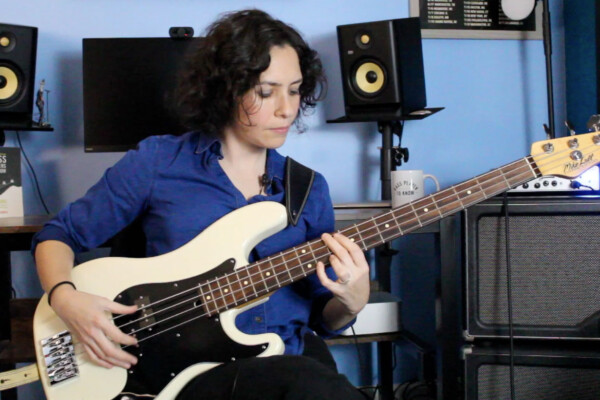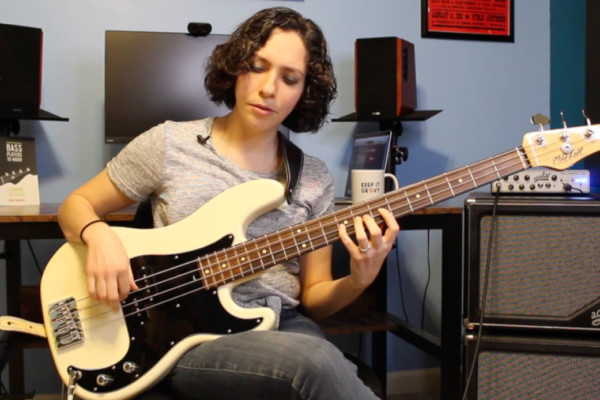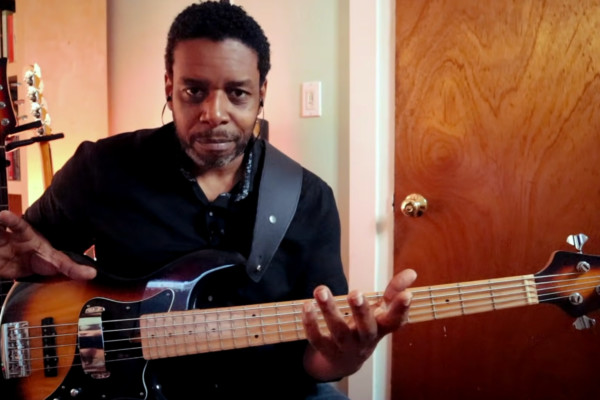Playing Chords: A Guide for Bassists
Q: I recently bought a 6-string bass and started working on playing chords. How should I voice more complex chords (e.g. Gm13) using few (3 to 4) notes, while maintaining the quality of the chord?
A: It is important to note a few things when doing this. Much of this is learned by doing it wrong and having someone correct you, but you should learn the difference between – for example – a 6 chord and a 13 chord.
Yes, the 6 is the same note as the 13, but they imply different things.
If it’s a 6 chord, that means that you should replace the 7th with the 6th.
If it’s a 13 chord, that means that the 6th is a “color tone”, and is used in addition to the 7th (which is flatted typically on a 13 chord!)
That’s just one example, but experiment with every possible voicing you can think of (they don’t always have to contain the root, either!)
I love to explore variations on a chord shape and, to do that, I will often:
- Experiment by moving one note in the chord up or down to another note in the scale to see how it sounds.
- Retain a chord shape but move the root somewhere and, if I like the sound, figure out what chord that might be outlining or implying. (for example moving the root of a C7#9 chord by a try-tone can give you a F#13 chord shape). This is one of the examples in the PDF.
Download this PDF, and you’ll find a few chords to try:
- The 1st (Maj9) is a little hard to finger but has a beautiful sound (Matthew Garrison uses this chord a lot)
- The 2nd (min9) is easier as you can bar the top and bottom notes. This might be my favorite chord on the bass.
- The next two are chords using the 6th (or 13)
- and, finally, a Maj7#11 voicing that I like and is easy to play.
Remember: You can always add or subtract notes. You can always substitute notes from within the scale. Just be sure to always explore the sound of the chord and also try to see the relationship to the chords around it in the tune.
The key is exploration. Find sounds you like and experiment with all scale tones within a chord to see how they affect the sound of it.
Have fun!
Note: To make this more accessible for everyone, my examples in the PDF will be using the tab for a 4-string (along with notation) but keep in mind that you can take any note and move it up (or down) an octave to span 5-, 6- or more strings. This is how I came up with many of the chord shapes that I use on my 6-string bass, and they’re just like my 3- or 4-string shape, but with notes transposed an octave. Basically, if you understand how chords are constructed, employing the use of upper structure tones (9, 11, 13) is as easy as moving one note by a step or two.
Readers, what would you recommend? Share your thoughts in the comments.
Have a question for Damian Erskine? Send it to [email protected]. Check out Damian’s instructional books, Right Hand Drive and The Improviser’s Path.




awesome! please post more lessons about chords :D
Technically, a 13th chord has to have the 13th ABOVE the 7th…just a clarification…and the chord you have listed as a minor 13th on your pdf (R – 6th – m10th) sounds more like a C- add 6 chord that it does a minor 13th…try R – m7th – m10th – 13th (from the bottom up G F Bye E..or you could put an F+7th chord over a G bass for a more sue like sound)…but nice article…
They should just buy my book
I wanted to make this work for 4 stringers, too so I didn’t include extended range chord shapes or fingerings but, yeah… for everyone out there, numbers above 7 are meant to be played above the 7th. Without two-handed tapping, tho.. that’d be hard on a root position 13 chord ;)
@[530771423:2048:Michael Dimin] or mine! ;)
http://www.cdbaby.com/cd/damianerskine2
Excellent lesson, but how in the name of GOD do you fret that first chord in the PDF? WOW that is tough. I really don’t think I could ever use something like that realistically in a composition because of the difficulty of hitting it in and out… but “Challenge Accepted” :) I really like coming across things like this to push my skills. Thank you.
yeah, that one is a little hard to just nail every time but, with practice you can. (Garrison uses this chord a LOT). I finger it 1-10-5-9 with fingers i-m-r-p
Yes good advice! If I can add is that if is it is a Maj13 chord than the seventh should be a maj7.
Keep up with the good postings!
yeah.. but if it just says 13 (i.e.: G13), than it is a flatted 7th. Just to keep it clear for everyone.
Useful article, thank you.
Good lesson Sir. I have a serious problem, I am able to play through the chord changes fairly well but if I try to improvise over them in a tune I always lose the form very easily. Could you assist me in get over this problem.
practice, practice, practice! like 100’s – 1000’s of hours of it ;)
…that should, of course, say “SUS” not ‘sue’…Johnny Cash would be proud (a chord named Sue…).
Very nice! I would add considerations about tone when playing chords, and considerations about “context” inside the song. Trying and error is a good advice, coz sometimes a voicing can be better that other and sometimes you can even replace the chord (re-harmonizing). It will depends on the melody and other contexts in the song… Regarding tone, it’s good to cut some lows and mid-lows while doing chords. A fat tone, which is really good to fingerstyle, may not be that good for playing 3-4 voicings chords.